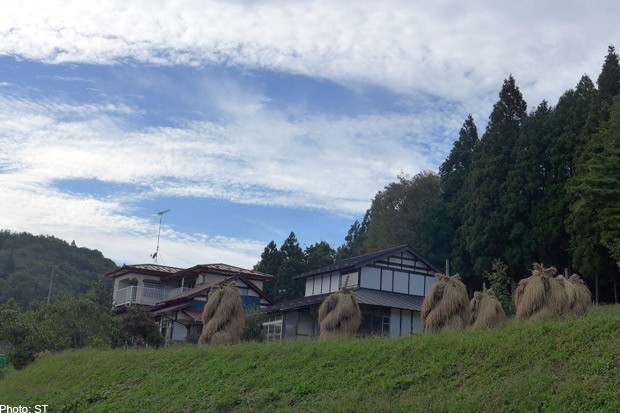Steps of a poet

I walk in the isolated north of Japan for five days, my senses awakened as I traipse through whispering cedar forests in misty rain.
It is a quest composed of many little sojourns that reveal the beauty of Japan - a trek on an ancient highway, a cruise around the pine-clad islands of Matsushima Bay, a climb up 2,466 steps to Mount Haguro. It is all very poetic.
After all, I am retracing the quixotic foot journey of poet-wanderer Matsuo Basho, who penned the timeless travelogue Narrow Road To The Deep North in the 17th century.
Written in an era of social turbulence, his classic, a blend of prose and haiku, evokes the Japanese sense of beauty and the transience of life. In middle age, the feted poet sold his house and devoted five months to traverse a 2,000km route in the spring of 1689 with a disciple-friend, Sora.
They were walking on the edge of civilisation in those days, for beyond lay a terrifying terrain of bandits and barbarians who roamed the mountains.
So the north, which includes the tsunamihit prefectures of Fukushima, Iwate and Miyagi, was an unexplored land that evoked mystery for Basho.
Today, this Tohoku region is still remote and little visited by non-Japanese. I barely see foreign faces on my sojourn with a dozen walkers on the first Basho Tour hosted by pioneering adventure company Walk Japan (www.walkjapan.com).
A 10-day trip, which starts in Tokyo and ends in Kyoto, costs 418,000 yen (S$5,350, see story on facing page). I ask for a compressed five-day version.
Like Basho, I begin my road trip in Tokyo, though we hop onto a blazing bullet train to Sendai, slicing off the urban sprawl in a couple of hours to focus on the far north. We walk 8 to 10km a day, a dreamy stroll compared to the 30 to 40km clocked by the tough-minded poet.But it is enough time and distance for me to savour the haiku moments of each day, whether we are looking at a salt cauldron in Shiogama or stopping at shrines to think about the afterlife.
Each new day brings a stream of highlights, which inspire my travel companions to write haikus on the move while I tweet instead. I have yet to compose any haiku about nature, though I have taken much delight in the following episodes.
MATSUSHIMA BAY, LONGEVITY PINES
The bay with its pine-clad islands is one of the beloved Three Views of Japan. The other two are the Amanohashidate sandbar in Kyoto and Itsukushima Shrine in Hiroshima. On a 50-minute cruise, we view the islands and their twisted pines, which symbolise long life and joy.
The place in Miyagi prefecture is lovely with a touch of whimsy. Locals say a tiny islet looks like the crest of a wave, and for me it does conjure up The Great Wave Off Kanagawa, a woodblock print by artist Hokusai. Then there is a cigar-smoking man, a heron taking flight and a fanciful pot island. Kanejima island apparently sounds like a bell when waves crash through its four crevices. Basho longed to visit the bay and later described the sight: "Islands are piled above islands."
HIRAIZUMI, ANCIENT WARRIORS
The moment I step off the local train into little Hiraizumi, I love its manicured beauty and intimate scale, which allows us to walk in minutes to its Motsu-ji Temple and gardens, and the trails beyond. Hiraizumi is Japan's newest World Heritage Site. The status was conferred in June 2011 and this uplifted northerners greatly three months after the tsunami, earthquake and nuclear scare.
Hiraizumi, 40km from the Pacific Coast, was spared the devastation. Indeed, its trails and temples are pristine, while the kabuki-like story of its powerful Fujiwara family, which reigned during the 11th and 12th centuries, still intrigues the modern soul. Under the Fujiwaras, Hiraizumi rivalled the old capital Kyoto in splendour, and the town in Iwate prefecture retains an exquisite spirit now. It feels like a less-explored gem, when I look at the quiet autumn-tinged gardens styled as a Buddhist "pure land paradise" by the Fujiwaras. Basho, catching echoes of the family's vanished glory, compared their ancient warriors to "summer grass".
DEWA SENDAI HIGHWAY, ENCHANTING FOREST
I imagine soldiers and sojourners such as Basho on this ancient national highway, which had its origins in 702 AD and was influenced by Chinese systems. The Edo highway is now a forest trail, wild and lovely, that is profusely signposted in Japanese and English. The boards carry facts and little narratives, such as the one about the merciful monkeys that sheltered and offered sake to a runaway ruler.
In mist-like rain, I trek through gorges with hairpin bends and over streams like Basho. But he had less fun than me. He was questioned by barrier guards on the highway, who viewed him with intense suspicion as he came from a land of ninjas.
He also slept at an inn in Yamagata prefecture infested by fleas and lice, he complained. When I visit the lovingly restored inn, however, my trek-weary toes are warmed by a fireplace built into the floorboards and I am soothed by the hot tea poured by a storytelling host. The inn, built with chestnut pillars, also has glass cases of straw sandals, replicas of those worn by Basho.

Get a copy of The Straits Times or go to straitstimes.com for more stories.